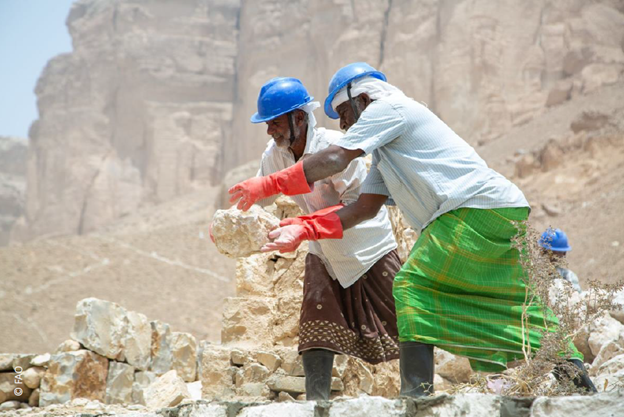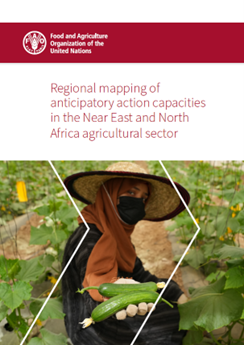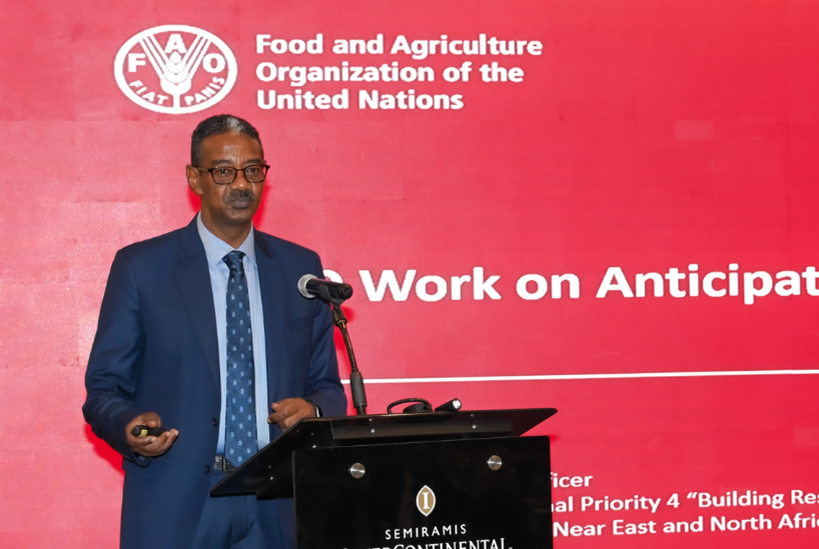Technical Expertise
From reaction to anticipation: Building agricultural resilience in the Near East and North Africa

A region facing converging risks
The Near East and North Africa (NENA) region is navigating an increasingly complex landscape of risks that threaten its agricultural systems and rural livelihoods. Droughts, floods, heatwaves and other climate extremes have become more frequent and severe, colliding with protracted conflicts, economic shocks, and disruptions to global food supply chains. These challenges are not isolated; they overlap, interact and magnify one another, leaving farmers and rural communities increasingly exposed.
Agriculture remains a critical lifeline for millions in the region. Yet, it is also among the sectors most at risk. Rural households often depend on fragile natural resources and seasonal rainfall, while the rising cost of inputs and market volatility further strain production systems. In this context, the question is no longer whether crises will happen, but how we can better prepare for them before they unfold.
Anticipatory action: acting before disaster strikes

The new FAO–IFPRI report, Regional mapping of anticipatory action capacities in the Near East and North Africa agricultural sector, provides a comprehensive look at how countries in the region are working to answer that question. Developed under Food and Agriculture Organization of the United Nation (FAO) Regional Priority 4: Building resilience to multiple shocks (RP4), the report represents a groundbreaking regional effort to assess existing anticipatory action systems, identify gaps, and chart a path forward for scaling up early action in agriculture.
Anticipatory action is a proactive approach that enables governments and partners to act in advance of an imminent shock, based on credible forecasts and predefined triggers. It connects early warning to early action, allowing for timely interventions such as distributing drought-tolerant seeds, providing livestock feed, or reinforcing irrigation systems before losses occur. By taking preventive measures rather than waiting for crises to escalate, countries can reduce the humanitarian and economic toll of disasters.
In the NENA region, where agriculture remains central to livelihoods and food security, this approach is both practical and essential. The report finds that drought and extreme heat events are particularly severe, often resulting in long-lasting disruptions to agricultural systems, compounded by conflict and economic shocks. According to the Emergency Events Database, droughts and floods have affected more people in NENA than any other type of disaster since 2000. The report also highlights that regional water productivity stands at only about half the global average, reflecting a structural challenge that continues to undermine agricultural sustainability.
What the data tells us
The regional mapping draws on over 130 survey responses and 40 in-depth interviews from 16 countries, offering the most detailed picture to date of the region’s anticipatory action landscape. The data shows clear progress in awareness and capacity development but also reveals substantial gaps that must be addressed if the region is to transition from reactive to proactive crisis management.
Financing remains a critical challenge. The NENA region currently receives only about 2.5 percent of global anticipatory action funding, with most initiatives relying heavily on international donors. Few countries have established national financing mechanisms to support early action in agriculture. Forecasting and early warning systems have improved significantly in recent years, but they remain fragmented and rarely tailored to agriculture-specific risks. Many systems focus on meteorological data but overlook critical agricultural indicators such as crop health, soil moisture, and pest dynamics.
Institutional frameworks are also still evolving. While most countries have well-structured disaster risk management systems, ministries of agriculture are rarely formal members. As a result, anticipatory action efforts are often led by humanitarian agencies rather than national agricultural institutions. This limits coordination and ownership and constrains the potential for sustainability.
Existing financial tools, including insurance and emergency funds, are typically reactive. In Morocco, for instance, weather-indexed insurance schemes pay out after losses occur rather than serving as triggers for early action. In Saudi Arabia, agricultural financing instruments such as the Agricultural Development Fund are crucial for recovery but are not yet linked to forecasts that could prompt pre-emptive responses.
Country experiences: lessons and opportunities
The report features case studies from Morocco, Egypt, Jordan, and Saudi Arabia, illustrating the diversity of experiences and the progress being made toward anticipatory approaches.
Morocco stands out for its gradual shift from reactive crisis management to structured, seasonal preparedness. The country’s Green Generation 2020–2030 strategy embeds climate resilience in its agricultural agenda, promoting drought-tolerant crops, drip irrigation, and water-saving incentives. Although not formally termed “anticipatory action,” targeted support measures for farmers, including early seed and livestock feed distributions, irrigation incentives, and access to subsidized inputs, can be triggered when rainfall and soil moisture indicators show signs of water scarcity, positioning Morocco as a regional example of proactive drought management.
In Egypt, growing attention is being given to integrated early warning systems that link the Ministry of Agriculture, the Ministry of Water Resources and Irrigation, and the Meteorological Authority. The country is also drafting new agricultural insurance legislation to support farmers in managing climate risks. Jordan has begun piloting digital platforms that combine weather data with agricultural planning to guide early interventions. Meanwhile, Saudi Arabia is expanding its meteorological network and exploring ways to connect climate forecasting with agricultural risk management and financing.
These examples demonstrate that the region is not starting from zero. Many of the building blocks for anticipatory action, forecasting capacity, institutional coordination, and pilot projects, already exist. The challenge lies in connecting them through structured protocols, financing mechanisms, and clear leadership.
Building a bridge between humanitarian and development goals
One of the report’s central messages is that anticipatory action should not be seen solely as a humanitarian response mechanism. It is equally a development and climate adaptation tool. By embedding anticipatory action into national disaster risk reduction, agricultural planning, and adaptation frameworks, countries can create systems that protect both immediate livelihoods and long-term food security.
This integration requires bridging the traditional divide between humanitarian and development programming. Anticipatory action complements ongoing efforts in climate-smart agriculture, social protection, and resilience-building. When linked to these existing systems, early action can serve as both a safety net during crises and an investment in sustainable development.
The report recommends prioritizing five areas of action: integrating anticipatory action into national strategies; establishing forecast-based financing; strengthening technical capacities and data systems; improving coordination among ministries, partners, and local actors; and empowering farmers and cooperatives to play a more active role in early warning and preparedness.
From vulnerability to resilience
The NENA region is at a pivotal moment. The risks it faces are intensifying, but so too is its capacity to anticipate and act. Anticipatory action provides a clear pathway to reduce losses, stabilize food production and safeguard livelihoods in the face of uncertainty. The FAO–IFPRI regional mapping report provides the evidence base and practical roadmap for countries to accelerate this shift.
By investing in early action and embedding it within agricultural systems, the region can move decisively from reaction to anticipation. This transition will not happen overnight, but each step toward proactive risk management represents progress toward resilience.
As I reflect on the findings of this report, one message stands out: agriculture must be placed at the heart of anticipatory action. Doing so will not only protect farmers and their families but also strengthen the food systems that sustain the region. As we look to the future, the goal is clear, to act before disaster strikes, to protect what sustains us, and to build a region that is resilient by design, not by necessity.
Author

Ayman Omer
Senior Field Programme Officer and Delivery Manager for the Regional Priority 4 (RP4) on Building resilience to multiple shocks, FAO Regional Office for the Near East and North Africa
[email protected]